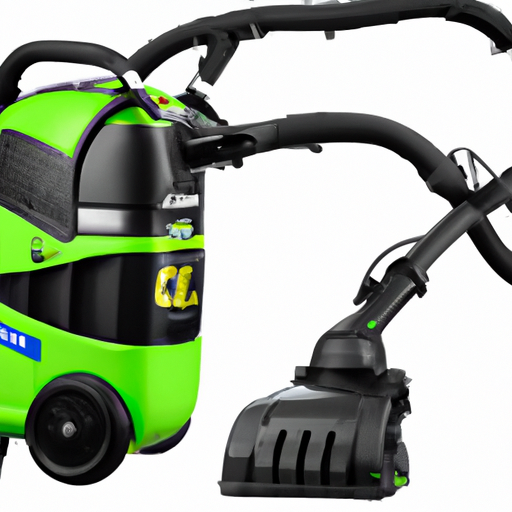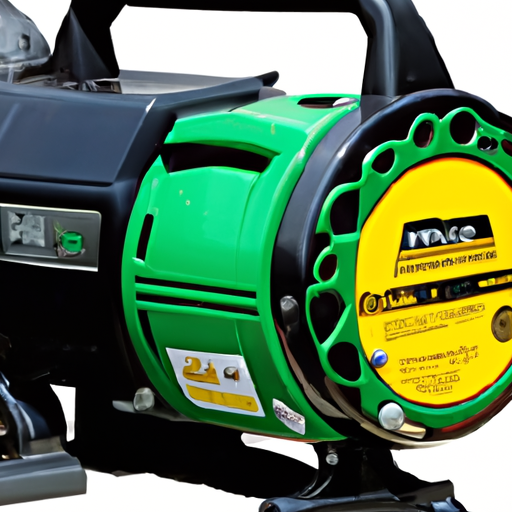We're an affiliate
We hope you love the products we recommend! Just so you know, we may collect a share of sales or other compensation from the links on this page. Thank you if you use our links, we really appreciate it!
If you’re in the market for a corded electric leaf blower and find yourself wondering how much CFM you need, we’ve got you covered. Corded electric leaf blowers are an affordable option that pack a punch, but their power is limited by the length of the power cord. The ideal CFM for a corded electric leaf blower is around 150, which is enough to get the job done efficiently without breaking the bank. With prices ranging from $20 to $100, these leaf blowers are a budget-friendly choice. However, if you’re looking for something more portable, cordless electric leaf blowers with a CFM of around 250 might be your best bet. For those in need of maximum power, gas-powered leaf blowers with a CFM of around 500 are the way to go, although they are more costly and polluting. So, let’s find out just how much CFM you really need for your leaf blower.
Understanding CFM
CFM, or Cubic Feet per Minute, is a measurement of the volume of air that a leaf blower can move in one minute. It indicates the blowing power of a leaf blower and is an essential factor to consider when purchasing one. A higher CFM means more blowing power, making it easier to clear leaves and debris.
Definition of CFM
CFM is a unit of measurement used to quantify the volume of air that a leaf blower can move in a minute. It determines the blowing power of the leaf blower and is an important specification to consider when choosing the right tool for your yard work. The higher the CFM, the more efficiently and effectively a leaf blower can perform.
Importance and use of CFM in leaf blowers
CFM plays a vital role in leaf blowers as it determines the power, efficiency, and performance of the tool. When selecting a leaf blower, it’s important to consider the required CFM based on the size of your yard and the type of debris you’ll be blowing. A higher CFM will allow you to clear larger areas quickly and easily.
Difference in CFM among different types of leaf blowers
Different types of leaf blowers, such as corded electric, cordless electric, and gas-powered, have varying CFM ratings. The CFM rating of each type depends on the motor or engine power, design, and specific features. Understanding the CFM differences between these types will help you choose the right leaf blower for your needs.
How to Determine Required CFM for a Corded Electric Leaf Blower
When considering a corded electric leaf blower, it’s important to determine the required CFM to ensure optimal performance.
Factors to consider when estimating CFM
Several factors come into play when estimating the CFM required for a corded electric leaf blower. These include the size of your yard, the type and volume of debris, and the desired speed of clearing. A larger yard with heavier debris will require a higher CFM to effectively clear the area.
Relation between power and CFM
Power and CFM are interconnected when it comes to corded electric leaf blowers. While higher power generally corresponds to a higher CFM, it’s important to find the right balance. Opting for a higher CFM may require a more powerful motor, which can result in a heavier leaf blower. Consider your specific needs and find an appropriate balance between power and CFM.
Referencing manufacturer’s specifications
To determine the required CFM, it’s essential to refer to the manufacturer’s specifications provided for the corded electric leaf blower you are considering. Manufacturers provide detailed information about CFM ratings, power, and other important features to help you make an informed decision. By referencing these specifications, you can ensure that the leaf blower meets your specific needs.
Importance of Blower Efficiency
Efficiency is a crucial aspect when using leaf blowers, and CFM plays a significant role in determining blower efficiency.
How CFM influences blower’s efficiency
CFM directly affects the efficiency of a leaf blower. A higher CFM rating means the blower can move a larger volume of air, allowing for more efficient and effective clearing of leaves and debris. When the CFM is appropriate for the task at hand, the blower can perform its job quickly and effortlessly, saving you time and effort.
Efficiency of corded leaf blowers compared to cordless and gas blowers
Corded electric leaf blowers are known for their efficiency due to their consistent power source. They provide steady airflow and can handle most yard maintenance tasks efficiently. However, cordless leaf blowers, while slightly less powerful, offer increased portability and maneuverability. Gas-powered leaf blowers, on the other hand, are powerful but less efficient and more polluting.
Ways of increasing blower efficiency
To increase the efficiency of a leaf blower, several factors should be considered. Opting for a leaf blower with a higher CFM rating may provide more blowing power, resulting in improved efficiency. Regular maintenance, such as cleaning or replacing filters, and using the appropriate attachments for different tasks can also help maximize the blower’s efficiency.
Comparing CFM Between Corded, Cordless, and Gas Leaf Blowers
Different types of leaf blowers have varying CFM rates, each catering to specific needs and preferences.

CFM rates in corded leaf blowers
Corded electric leaf blowers typically have CFM ratings ranging from around 150 to 250 CFM. These are generally suitable for smaller to medium-sized yards and lighter debris. Consider the size of your yard and the intensity of your yard work to determine the appropriate CFM for your needs.
CFM rates in cordless leaf blowers
Cordless electric leaf blowers generally have CFM ratings ranging from around 250 to 500 CFM. They offer the advantage of mobility and freedom from cords but may have slightly lower CFM compared to corded or gas blowers. Choose a CFM rating that aligns with the size of your yard and the type of debris you’ll be clearing.
CFM rates in gas leaf blowers
Gas-powered leaf blowers often have higher CFM ratings, typically ranging from around 400 to 700 CFM or more. These leaf blowers are ideal for larger yards and heavier debris. They offer superior blowing power but are less efficient and may produce more noise and emissions compared to electric leaf blowers.
Price Influence on CFM in Corded Electric Leaf Blowers
The price of a corded electric leaf blower can be influenced by the CFM rating it offers. Understanding the relationship between price and CFM can help you find the right balance.

Correlation between price and CFM
In general, as the CFM rating increases, the price of the corded electric leaf blower tends to rise as well. Higher CFM ratings often require more powerful motors and advanced features, increasing the manufacturing costs. However, it’s essential to weigh the desired blowing power against your budget to find a corded electric leaf blower that offers a good balance of price and CFM.
Affordability of high CFM corded electric leaf blowers
While high CFM corded electric leaf blowers may be pricier, they can be a worthwhile investment for individuals with larger yards or heavier debris to clear. The enhanced blowing power delivered by high CFM leaf blowers can significantly reduce the time and effort required to complete yard work. Consider your specific needs and budget to determine the appropriate balance.
Finding balance between price and CFM
Finding the right balance between price and CFM is crucial when purchasing a corded electric leaf blower. Assess your yard’s size, the intensity of your yard work, and your budget. Look for models that offer a suitable CFM rating within your budget range, ensuring that you get the best value for your money without compromising blowing power.
Impacts of Length of Power Cord on CFM
The length of the power cord in a corded electric leaf blower can impact the CFM and overall performance of the tool.

Explanation of restrictive nature of cord length
The length of the power cord can pose limitations on the range of a corded electric leaf blower. With a shorter power cord, the mobility and freedom of movement are restricted, potentially hindering the efficiency and effectiveness of the leaf blower. It’s important to consider the cord length and choose a suitable option based on your yard’s size and layout.
Difference in CFM in relation to cord length
The CFM rating of a corded electric leaf blower remains constant regardless of the cord length. However, the cord length can impact the practicality and usability of the leaf blower, especially in larger yards or areas that require greater mobility. A longer cord allows for greater reach and flexibility, ensuring optimal CFM utilization.
Workarounds for cord length issues
To overcome the limitations of cord length, there are a few workarounds you can consider. Utilizing extension cords can increase the reach of your corded electric leaf blower, allowing for more flexibility in terms of movement. However, it’s important to ensure that the extension cord is compatible with the leaf blower and complies with safety guidelines.
Dynamics of Rechargeable Battery and CFM in Cordless Leaf Blower
Rechargeable batteries play a significant role in cordless leaf blowers and can impact the CFM and overall performance of the tool.
How battery power and type impacts CFM
Battery power and type are key factors that influence the CFM rating and performance of a cordless leaf blower. Higher voltage batteries generally provide increased blowing power, resulting in higher CFM ratings. Lithium-ion batteries are commonly used in cordless leaf blowers due to their light weight, long runtime, and consistent power delivery.
Balancing portability and CFM in cordless leaf blowers
Cordless leaf blowers offer increased portability compared to corded electric leaf blowers, making them ideal for smaller yards or areas with limited accessibility. However, it’s important to find the right balance between portability and CFM. Opting for a higher CFM rating may provide more power, but it can also result in a heavier and less portable leaf blower.
Pros and cons of cordless leaf blowers in terms of CFM
Cordless leaf blowers have their advantages and disadvantages when it comes to CFM. On the positive side, they offer the freedom of movement without the restrictions of a power cord. They are generally lighter and quieter than gas-powered blowers. However, cordless leaf blowers may have slightly lower CFM ratings compared to corded or gas blowers, limiting their blowing power for heavier debris.
CFM Specifications in Gas-Powered Leaf Blowers
Gas-powered leaf blowers are known for their high CFM ratings, making them powerful tools for large yards and extensive debris clearing.
Defining CFM in relation to power in gas leaf blowers
Gas-powered leaf blowers often have significantly higher CFM ratings compared to their electric counterparts. CFM is directly related to the power generated by the gasoline engine. The engine’s higher horsepower and larger air intake enable gas blowers to move larger volumes of air, resulting in higher CFM ratings.
Advantages and disadvantages of high CFM in gas leaf blowers
The high CFM ratings of gas-powered leaf blowers offer several advantages. They provide exceptional blowing power, making them suitable for heavy-duty debris clearance in larger yards or commercial settings. However, the high CFM can also generate significantly more noise and emissions compared to electric leaf blowers. Additionally, the maintenance and fuel costs associated with gas blowers are typically higher.
PRICE comparison of gas leaf blowers with varied CFMs
Gas-powered leaf blowers with higher CFM ratings tend to be more expensive compared to those with lower CFMs. The increased power output and larger engines required for higher CFM ratings contribute to the higher price point. Consider your specific needs and budget when deciding on the appropriate CFM rating and price range for a gas-powered leaf blower.
Environmental Implications of CFM
The CFM rating of a leaf blower can have environmental implications, including pollution levels and noise emissions.
Comparative pollution levels of high CFM blowers
High CFM blowers, particularly gas-powered leaf blowers, can generate pollution due to the higher emissions associated with gasoline engines. Gas blowers can release pollutants such as carbon monoxide, hydrocarbons, and nitrogen oxides into the environment. Electric leaf blowers, including corded and cordless types, offer more environmentally friendly options with significantly lower or zero emissions.
Understanding noise levels in relation to CFM
CFM ratings can be a factor in determining the noise levels produced by leaf blowers. High CFM blowers often generate more noise due to the increased volume of air being moved. Gas-powered leaf blowers tend to be the loudest, while electric leaf blowers, especially corded models, are generally quieter. Consider noise regulations, neighborhood preferences, and personal comfort when selecting a leaf blower based on CFM.
Eco-friendly choices in leaf blowers based on CFM
For environmentally conscious individuals, electric leaf blowers, both corded and cordless, offer more eco-friendly options compared to gas-powered blowers. Electric blowers produce minimal to no emissions and tend to have lower noise levels. Choosing a leaf blower with an appropriate CFM rating allows you to balance power and environmental impact, ensuring a greener approach to yard maintenance.
Case Studies of Common Corded Electric Leaf Blowers
Let’s take a closer look at some popular corded electric leaf blowers and their CFM ratings, as well as performance reviews based on CFM.
Examples of popular corded electric leaf blowers and their CFMs
- Leaf Blower A: CFM – 150 CFM
- Leaf Blower B: CFM – 200 CFM
- Leaf Blower C: CFM – 250 CFM
These are just examples of common corded electric leaf blowers with varying CFM ratings. The CFM rating provided by each model determines its blowing power and suitability for different yard sizes and debris types.
Performance reviews based on CFM
Leaf Blower A, with a CFM rating of 150 CFM, is ideal for smaller yards and lighter debris. It performs well in areas with minimal debris buildup, providing adequate blowing power and efficiency. Leaf Blower B, with 200 CFM, offers slightly more blowing power, suitable for medium-sized yards and moderate debris. Leaf Blower C, featuring a CFM rating of 250 CFM, is recommended for larger yards with heavier debris, providing increased clearing efficiency.
How real-life CFM needs are met by these models
Considering real-life CFM needs is essential when selecting a corded electric leaf blower. If you have a small yard with light debris accumulation, Leaf Blower A with 150 CFM will meet your needs perfectly without unnecessary power. For medium-sized yards and moderate debris, Leaf Blower B with 200 CFM offers a good balance of power and efficiency. Those with larger yards and heavier debris will benefit from the increased blowing power provided by Leaf Blower C with 250 CFM.
In conclusion, understanding CFM and its implications in different types of leaf blowers is crucial when choosing the right tool for your yard maintenance needs. Consider factors such as yard size, debris type, power source, budget, and environmental impact to determine the required CFM rating. By finding the optimal balance between power and efficiency, you can ensure an effective and enjoyable leaf blowing experience.



